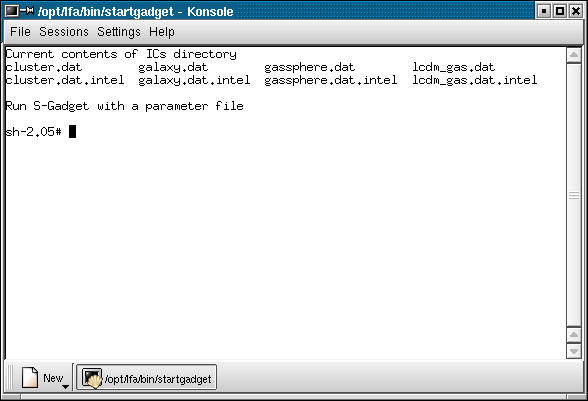Contents
Previous
Next
A code for collisionless and gasdynamical cosmological simulations
Version : 1.1
Author(s) : Volker Springel (vspringel@cfa.harvard.edu) , Naoki
Yoshida (naoki@mpa-garching.mpg.de)
License : GPL
Website :
http://www.mpa-garching.mpg.de/gadget/
Disk space required for installation is 23.32 Mb
After the package is installed it can be accessed using the command
/opt/lfa/startgadget
The following printable documents will be installed :
Summary
In its current implementation, the serial and parallel versions of
GADGET (GAlaxies with Dark matter and Gas intEracT1) support
collisionless simulations and smoothed
particle hydrodynamics on serial or massively parallel computers.
While the parallel code required substantial changes in certain parts
of the computational algorithms, we have nevertheless
tried to keep the structure of the two codes, and their usuage, as
similar as possible. In principle, it would be possible to merge the
codes into one source, and employ large numbers of
compiler directives to generate serial or parallel behaviour as
desired. However, we think that would make the code much more opaque,
and would compromise one of our objectives, which is
to provide a clean, well-documented code that can be easily
understood and modified by users. We therefore provide two separate
versions of the code, one for serial and one for parallel
computations.
The code can be used for plain Newtonian dynamics, or for
cosmological integrations in arbitrary cosmologies, both with or
without periodic boundary conditions. The modeling of
hydrodynamics is optional. The code is fully adaptive both in space
and in time.
The main reference for numerical and algorithmic aspects of the
code is the paper `GADGET: A code for collisionless and gas-dynamical
cosmological simulations', Springel, Yoshida White, 2000, submitted to
New Astronomy (see preprint at astro-ph/0003162). In the following,
this paper will be frequently referenced, and I recommend reading it
before you attempt to use
the code.
Features
Hierarchical multipole expansion (tree method) for gravitational
forces (geometrical oct-tree, Barnes
Optional periodic boundary conditions (Ewald summation technique)
Smoothed particle hydrodynamics with fully adaptive smoothing
lengths
Shear-reduced artificial viscosity
Individual timesteps of arbitrary size for all particles
Work-load balancing and dynamic tree updates
Efficient cell-opening criteria
Highly efficient integrator in the linear regime of gravitational
clustering
Flexible control of all code options by a free-format parameterfile
Portable, well documented code, relying only on standard
language/communication features
High raw computational speed and good scalability
Screenshots

Contents
Previous
Next

